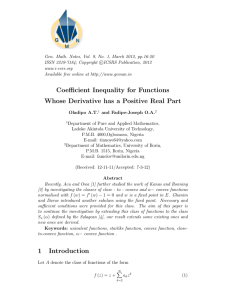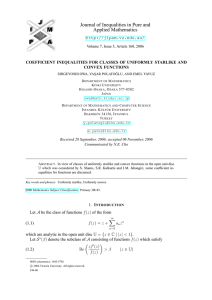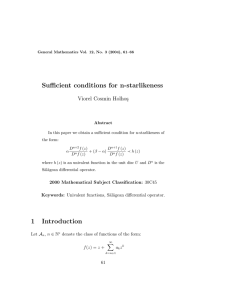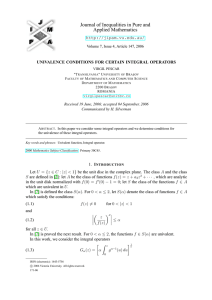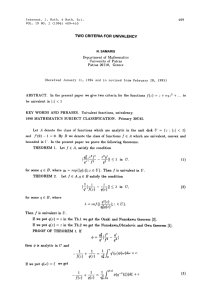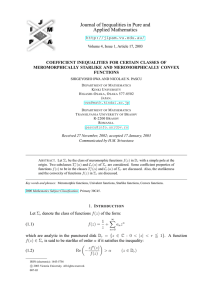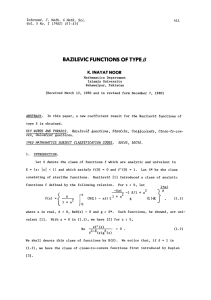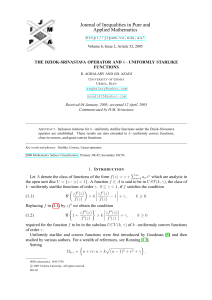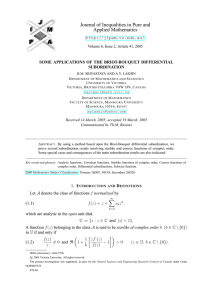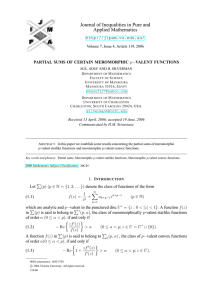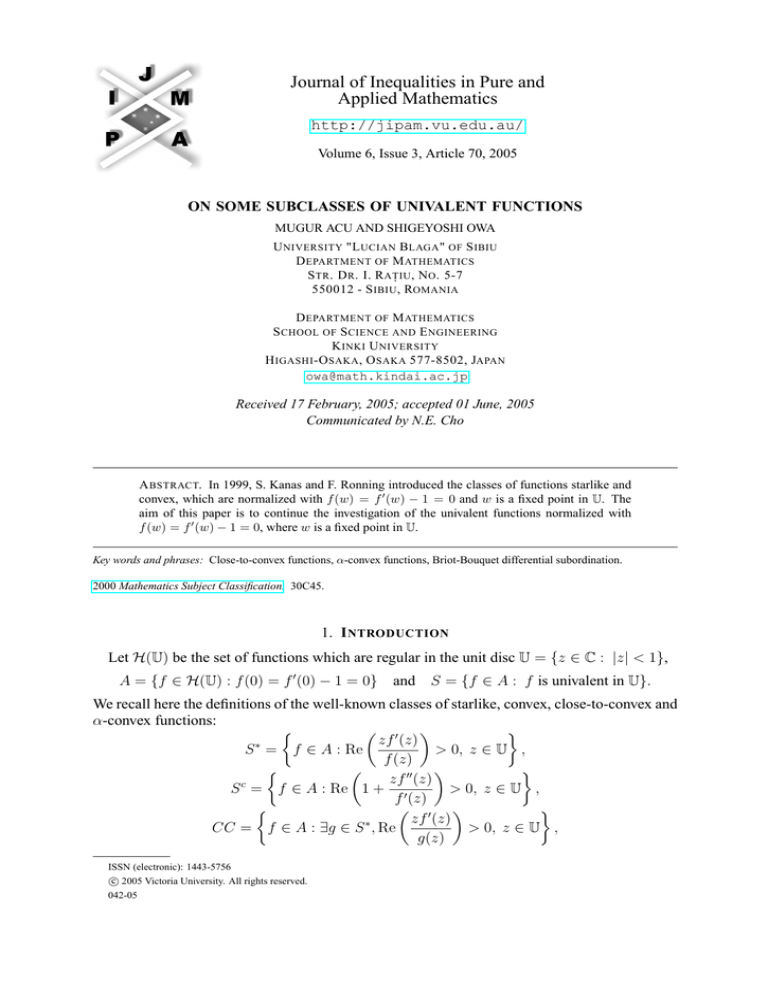
Journal of Inequalities in Pure and
Applied Mathematics
http://jipam.vu.edu.au/
Volume 6, Issue 3, Article 70, 2005
ON SOME SUBCLASSES OF UNIVALENT FUNCTIONS
MUGUR ACU AND SHIGEYOSHI OWA
U NIVERSITY "L UCIAN B LAGA " OF S IBIU
D EPARTMENT OF M ATHEMATICS
S TR . D R . I. R AT. IU , N O . 5-7
550012 - S IBIU , ROMANIA
D EPARTMENT OF M ATHEMATICS
S CHOOL OF S CIENCE AND E NGINEERING
K INKI U NIVERSITY
H IGASHI -O SAKA , O SAKA 577-8502, JAPAN
owa@math.kindai.ac.jp
Received 17 February, 2005; accepted 01 June, 2005
Communicated by N.E. Cho
A BSTRACT. In 1999, S. Kanas and F. Ronning introduced the classes of functions starlike and
convex, which are normalized with f (w) = f 0 (w) − 1 = 0 and w is a fixed point in U. The
aim of this paper is to continue the investigation of the univalent functions normalized with
f (w) = f 0 (w) − 1 = 0, where w is a fixed point in U.
Key words and phrases: Close-to-convex functions, α-convex functions, Briot-Bouquet differential subordination.
2000 Mathematics Subject Classification. 30C45.
1. I NTRODUCTION
Let H(U) be the set of functions which are regular in the unit disc U = {z ∈ C : |z| < 1},
A = {f ∈ H(U) : f (0) = f 0 (0) − 1 = 0} and
S = {f ∈ A : f is univalent in U}.
We recall here the definitions of the well-known classes of starlike, convex, close-to-convex and
α-convex functions:
0 zf (z)
∗
S = f ∈ A : Re
> 0, z ∈ U ,
f (z)
zf 00 (z)
c
S = f ∈ A : Re 1 + 0
> 0, z ∈ U ,
f (z)
0 zf (z)
∗
CC = f ∈ A : ∃g ∈ S , Re
> 0, z ∈ U ,
g(z)
ISSN (electronic): 1443-5756
c 2005 Victoria University. All rights reserved.
042-05
2
M UGUR ACU AND S HIGEYOSHI OWA
f (z)f 0 (z)
Mα = f ∈ A :
6= 0, Re J(α, f : z) > 0, z ∈ U ,
z
where
zf 0 (z)
zf 00 (z)
J(α, f ; z) = (1 − α)
+α 1+ 0
.
f (z)
f (z)
Let w be a fixed point in U and A(w) = {f ∈ H(U) : f (w) = f 0 (w) − 1 = 0}.
In [3], S. Kanas and F. Ronning introduced the following classes:
S(w) = {f ∈ A(w) : f is univalent in U}
(z − w)f 0 (z)
∗
> 0, z ∈ U
ST (w) = S (w) = f ∈ S(w) : Re
f (z)
(z − w)f 00 (z)
c
> 0, z ∈ U .
CV (w) = S (w) = f ∈ S(w) : 1 + Re
f 0 (z)
The class S ∗ (w) is defined by the geometric property that the image of any circular arc
centered at w is starlike with respect to f (w) and the corresponding class S c (w) is defined
by the property that the image of any circular arc centered at w is convex. We observe that
the definitions are somewhat similar to the ones for uniformly starlike and convex functions
introduced by A. W. Goodman in [1] and [2], except that in this case the point w is fixed.
It is obvious that there exists a natural "Alexander relation" between the classes S ∗ (w) and
c
S (w):
g ∈ S c (w) if and only if f (z) = (z − w)g 0 (z) ∈ S ∗ (w).
Let P(w) denote the class of all functions
p(z) = 1 +
∞
X
Bn (z − w)n
n=1
that are regular in U and satisfy p(w) = 1 and Re p(z) > 0 for z ∈ U.
The purpose of this note is to define the classes of close to convex and α-convex functions
normalized with f (w) = f 0 (w) − 1 = 0, where w is a fixed point in U, and to obtain some
results concerning these classes.
2. P RELIMINARY R ESULTS
It is easy to see that a function f ∈ A(w) has the series expansion:
f (z) = (z − w) + a2 (z − w)2 + · · · .
In [7], J.K. Wald gives the sharp bounds for the coefficients Bn of the function p ∈ P(w) as
follows.
Theorem 2.1. If p ∈ P(w),
p(z) = 1 +
∞
X
Bn (z − w)n ,
n=1
then
(2.1)
|Bn | ≤
2
,
(1 + d)(1 − d)n
where d = |w| and n ≥ 1.
Using the above result, S. Kanas and F. Ronning [3] obtain the following:
J. Inequal. Pure and Appl. Math., 6(3) Art. 70, 2005
http://jipam.vu.edu.au/
O N S OME S UBCLASSES OF U NIVALENT F UNCTIONS
3
Theorem 2.2. Let f ∈ S ∗ (w) and f (z) = (z − w) + a2 (z − w)2 + · · · . Then
(2.2)
(2.3)
3+d
2
, |a3 | ≤
,
2
1−d
(1 − d2 )2
2 (2 + d)(3 + d)
1 (2 + d)(3 + d)(3d + 5)
|a4 | ≤
, |a5 | ≤
2
3
3 (1 − d )
6
(1 − d2 )4
|a2 | ≤
where d = |w|.
Remark 2.3. It is clear that the above theorem also provides bounds for the coefficients of
functions in S c (w), due to the relation between S c (w) and S ∗ (w).
The next theorem is the result of the so called "admissible functions method" introduced by
P.T. Mocanu and S.S. Miller (see [4], [5], [6]).
Theorem 2.4. Let h be convex in U and Re[βh(z) + γ] > 0, z ∈ U. If p ∈ H(U) with
p(0) = h(0) and p satisfies the Briot-Bouquet differential subordination
p(z) +
zp0 (z)
≺ h(z),
βp(z) + γ
z ∈ U,
then p(z) ≺ h(z), z ∈ U.
3. M AIN R ESULTS
Let us consider the integral operator La : A(w) → A(w) defined by
Z z
1+a
(3.1)
f (z) = La F (z) =
F (t)(t − w)a−1 dt, a ∈ R, a ≥ 0.
a
(z − w) w
We denote by
w
z(1 + z)
< 1 and Re
>0 ,
D(w) = z ∈ U : Re
z
(z − w)(1 − z)
with D(0) = U, and
s(w) = {f : D(w) → C} ∩ S(w),
where w is a fixed point in U. Denoting s∗ (w) = S ∗ (w) ∩ s(w), where w is a fixed point in U,
we obtain
Theorem 3.1. Let w be a fixed point in U and F (z) ∈ s∗ (w). Then f (z) = La F (z) ∈ S ∗ (w),
where the integral operator La is defined by (3.1).
Proof. By differentiating (3.1), we obtain
(1 + a)F (z) = af (z) + (z − w)f 0 (z).
(3.2)
From (3.2), we also have
(3.3)
(1 + a)F 0 (z) = (1 + a)f 0 (z) + (z − w)f 00 (z).
Using (3.2) and (3.3), we obtain
0
(3.4)
00
(z)
(z)
(1 + a)(z − w) ff (z)
+ (z − w)2 ff (z)
(z − w)F 0 (z)
=
.
0
F (z)
a + (z − w) f (z)
f (z)
Letting
p(z) =
J. Inequal. Pure and Appl. Math., 6(3) Art. 70, 2005
(z − w)f 0 (z)
,
f (z)
http://jipam.vu.edu.au/
4
M UGUR ACU AND S HIGEYOSHI OWA
where p ∈ H(U) and p(0) = 1, we have
f 00 (z)
(z − w)p (z) = p(z) + (z − w) ·
− [p(z)]2
f (z)
0
2
and thus
f 00 (z)
= (z − w)p0 (z) − p(z)[1 − p(z)].
f (z)
Using (3.4) and (3.5), we obtain
(z − w)F 0 (z)
(z − w)p0 (z)
(3.6)
= p(z) +
.
F (z)
a + p(z)
Since F ∈ s∗ (w), from (3.6), we have
1+z
z−w 0
p(z) +
p (z) ≺
≡ h(z)
a + p(z)
1−z
or
1 − wz
1+z
zp0 (z) ≺
.
p(z) +
a + p(z)
1−z
From the hypothesis, we have
1
a
Re
h(z) +
>0
1 − wz
1 − wz
(3.5)
(z − w)2
and thus from Theorem 2.4, we obtain
1+z
, z∈U
1−z
(z − w)f 0 (z)
Re
> 0, z ∈ U.
f (z)
p(z) ≺
or
This means that f ∈ S ∗ (w).
Definition 3.1. Let f ∈ S(w) where w is a fixed point in U. We say that f is w-close-to-convex
if there exists a function g ∈ S ∗ (w) such that
(z − w)f 0 (z)
Re
> 0, z ∈ U.
g(z)
We denote this class by CC(w).
Remark 3.2. If we consider f = g, g ∈ S ∗ (w), then we have S ∗ (w) ⊂ CC(w). If we take
w = 0, then we obtain the well-known close-to-convex functions.
Theorem 3.3. Let w be a fixed point in U and f ∈ CC(w), where
∞
X
f (z) = (z − w) +
bn (z − w)n ,
n=2
∗
with respect to the function g ∈ S (w), where
g(z) = (z − w) +
∞
X
an (z − w)n .
n=2
Then
"
#
n−1
X
1
2
|an | +
|ak | ·
,
|bn | ≤
n
(1 + d)(1 − d)n−k
k=1
J. Inequal. Pure and Appl. Math., 6(3) Art. 70, 2005
http://jipam.vu.edu.au/
O N S OME S UBCLASSES OF U NIVALENT F UNCTIONS
5
where d = |w|, n ≥ 2 and a1 = 1.
Proof. Let f ∈ CC(w) with respect to the function g ∈ S ∗ (w). Then there exists a function
p ∈ P(w) such that
(z − w)f 0 (z)
= p(z),
g(z)
where
∞
X
p(z) = 1 +
Bn (z − w)n .
n=1
Using the hypothesis through identification of (z − w)n coefficients, we obtain
(3.7)
nbn = an +
n−1
X
ak Bn−k ,
k=1
where a1 = 1 and n ≥ 2. From (3.7), we have
"
#
n−1
X
1
|an | +
|ak | · |Bn−k | ,
|bn | ≤
n
k=1
a1 = 1, n ≥ 2.
Applying the above and the estimates (2.1), we obtain the result.
Remark 3.4. If we use the estimates (2.2), we obtain the same estimates for the coefficients bn ,
n = 2, 3, 4, 5.
Definition 3.2. Let α ∈ R and w be a fixed point in U. For f ∈ S(w), we define
(z − w)f 00 (z)
(z − w)f 0 (z)
J(α, f, w; z) = (1 − α)
+α 1+
.
f (z)
f 0 (z)
We say that f is w − α−convex function if
f (z)f 0 (z)
6= 0, z ∈ U
z−w
and Re J(α, f, w; z) > 0, z ∈ U. We denote this class by Mα (w).
Remark 3.5. It is easy to observe that Mα (0) is the well-known class of α-convex functions.
Theorem 3.6. Let w be a fixed point in U, α ∈ R, α ≥ 0 and mα (w) = Mα (w) ∩ s(w). Then
we have
(1) If f ∈ mα (w) then f ∈ S ∗ (w). This means mα (w) ⊂ S ∗ (w).
(2) If α, β ∈ R, with 0 ≤ β/α < 1, then mα (w) ⊂ mβ (w).
Proof. From f ∈ mα (w), we have Re J(α, f, w; z) > 0, z ∈ U. Putting
(z − w)f 0 (z)
p(z) =
,
f (z)
with p ∈ H(U) and p(0) = 1, we obtain
(z − w)p0 (z)
Re J(α, f, w; z) = Re p(z) + α
> 0,
p(z)
or
α 1 − wz
1+z
p(z) +
zp0 (z) ≺
≡ h(z).
p(z)
1−z
J. Inequal. Pure and Appl. Math., 6(3) Art. 70, 2005
z∈U
http://jipam.vu.edu.au/
6
M UGUR ACU AND S HIGEYOSHI OWA
In particular, for α = 0, we have
p(z) ≺
1+z
,
1−z
z ∈ U.
Using the hypothesis, we have for α > 0,
Re
!
1
h(z) > 0,
α 1 − wz
z∈U
and from Theorem 2.4, we obtain
1+z
, z ∈ U.
1−z
(z − w)f 0 (z)
Re
> 0, z ∈ U
f (z)
p(z) ≺
This means that
for α ≥ 0 or f ∈ S ∗ (w).
If we denote by A = Re p(z) and B = Re ((z − w)p0 (z)/p(z)), then we have A > 0 and
A + Bα > 0, where α ≥ 0. Using the geometric interpretation of the equation y(x) = A + Bx,
x ∈ [0, α], we obtain
y(β) = A + Bβ > 0 for every β ∈ [0, α].
This means that
(z − w)p0 (z)
Re p(z) + β
p(z)
> 0,
z∈U
or f ∈ mβ (w).
Remark 3.7. From Theorem 3.6, we have
m1 (w) ⊆ sc (w) ⊆ mα (w) ⊆ s∗ (w),
where 0 ≤ α ≤ 1 and sc (w) = S c (w) ∩ s(w).
R EFERENCES
[1] A.W. GOODMAN, On Uniformly Starlike Functions, J. Math. Anal. Appl., 155 (1991), 364–370.
[2] A.W. GOODMAN, On uniformly convex functions, Ann. Polon. Math., 56 (1991), 87–92.
[3] S. KANAS AND F. RONNING, Uniformly starlike and convex functions and other related classes of
univalent functions, Ann. Univ. Mariae Curie - Sklodowska Section A, 53 (1999), 95–105.
[4] S.S. MILLER AND P.T. MOCANU, Differential subordonations and univalent functions, Michigan
Math. J., 28 (1981), 157–171.
[5] S.S. MILLER AND P.T. MOCANU, Univalent solutions of Briot-Bouquet differential equations, J.
Diff. Eqns., 56 (1985), 297–309.
[6] S.S. MILLER AND P.T. MOCANU, On some classes of first-order differential subordinations, Michigan Math. J., 32 (1985), 185–195.
[7] J.K. WALD, On Starlike Functions, Ph. D. thesis, University of Delaware, Newark, Delaware (1978).
J. Inequal. Pure and Appl. Math., 6(3) Art. 70, 2005
http://jipam.vu.edu.au/

